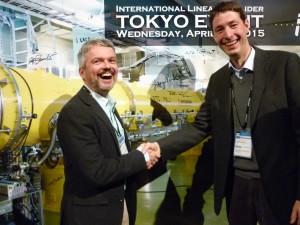
Former CALICE spokesman and current chair of the Steering Board Felix Sefkow congratulates Frank Simon on his new role.
CALICE, the collaboration of detector developers working on calorimeters for the linear collider, has a new spokesperson. At their meeting during the ALCW2015 workshop, the collaboration elected Frank Simon from the Max Planck Institute for Physics in Munich, Germany, as their new head. He takes over from Jose Repond, Argonne National Lab.
The CALICE collaboration unites 336 physicists and engineers from 57 institutes and 17 countries in their goal to develop, test and build different calorimeters for future linear collider detectors. Calorimeters measure the energy of passing particles and come in two different varieties: electromagnetic and hadronic. For each of these there are several options on the table – analog, semidigital or digital, and using different materials – for the not-yet-built detectors, and time will tell which option will get the go-ahead.
The calorimeters are core contributors to the particle flow algorithm, a concept that is supposed to provide the highest ever energy resolution for particle jets in a detector, making it possible to identify and track every single particle from a collision. The particle-flow calorimeter looks at where the energy was deposited as a precise three-dimensional picture with very high resolution, not how much particle energy was deposited in a broad volume, as is typical for calorimeters in use today.
Like all R&D projects for the ILC, the CALICE collaboration is in a transition phase – it can turn from potential into actual project at any moment. “For us this means that we will do everything that is possible and necessary to facilitate a decision for high-granular calorimeter systems for the ILC detectors,” says Frank Simon. He thinks that CALICE will play a major, and model, role in the formation of approved detector collaborations: “Having developed and tested all major calorimeter technologies and improved shower simulations and the GEANT4 simulation software, the collaboration has shown that it is capable of developing state-of-the-art subdetectors and that its concepts and technologies go far beyond the collaboration’s boundaries.” Other projects like the detectors at the Large Hadron Collider at CERN have shown interest in using CALICE technologies, and the new spokesman is keen to tap the potential of these related projects.
Further reading: Common ground in ILC and CLIC detector concepts, particle flow, CALICE

Recent Comments